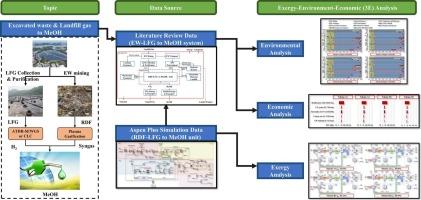Landfill gas as the external hydrogen source to enhance the methanol production from excavated waste: The choice of the chemical looping and the autothermal dry reforming integrated with sorption-enhanced water gas shift
IF 7
2区 工程技术
Q1 ENERGY & FUELS
Sustainable Energy Technologies and Assessments
Pub Date : 2025-08-29
DOI:10.1016/j.seta.2025.104552
引用次数: 0
Abstract
The in-situ utilization of landfill gas (LFG) as the extra H2 source can boost the methanol (MeOH) production from the excavated waste (EW). In this study, EW&LFG-to-MeOH life-cycle systems with different LFG reforming ways, including the chemical looping (CL) and the autothermal dry reforming integrated with sorption-enhanced water gas shift (ATDR-SEWGS), are proposed. Schemes are named after letter A & B (denoting using 05EW and 15EW) and number 1 & 2 (denoting applying ATDR-SEWGS and CL). Results show that higher thermal self-satisfaction demands and reduced MeOH yield has brought the lower ηex in Scheme A2 (59.69 %) and B2 (60.79 %) than that of Scheme A1 (63.10 %) and B1 (63.21 %). The drop in the MeOH yield is more influential than the reduced energy consumption to the global warming (GW) impacts. The life-cycle GW for Schemes A1, A2, B1, and B2 is respective 866.81, 892.98, 512.39, and 524.74 kgCO2eq/tonMeOH. Economically, as the decrease in TCI and APC of the Schemes A2/B2 is more advantageous than the increase of AIC, reporting higher NPV of Schemes A2/B2 (79.27/75.96 M$) than that of Schemes A1/B1 (72.43/63.60 M$). In conclusion, Schemes A1/B1 and A2/B2 are preferable in environmental and economic aspects, respectively.

垃圾填埋气作为外氢源提高挖掘废弃物甲醇产量:选择化学环法和自热干法重整结合吸附强化水煤气转换
就地利用垃圾填埋气(LFG)作为额外的氢气源,可以提高挖掘废弃物(EW)的甲醇(MeOH)产量。在本研究中,提出了不同LFG转化方式的EW&;LFG- meoh生命周期系统,包括化学环(CL)和吸附增强水气转换(ATDR-SEWGS)的自热干法转化。方案以字母A & &; B(表示使用05EW和15EW)和数字1 & &;2(表示使用ATDR-SEWGS和CL)命名。结果表明,较高的热自满足要求和较低的MeOH产率使A2和B2方案的ηex(59.69%)低于A1方案(63.10%)和B1方案(63.21%)。MeOH产率的下降对全球变暖的影响大于能源消耗的减少。方案A1、A2、B1和B2的生命周期GW分别为866.81、892.98、512.39和524.74 kgCO2eq/tonMeOH。在经济上,由于计划A2/B2的TCI和APC的下降比AIC的增加更有利,计划A2/B2的净现值(79.27/75.96 M$)高于计划A1/B1 (72.43/ 6360 M$)。综上所述,方案A1/B1和A2/B2分别在环境和经济方面更可取。
本文章由计算机程序翻译,如有差异,请以英文原文为准。
求助全文
约1分钟内获得全文
求助全文
来源期刊

Sustainable Energy Technologies and Assessments
Energy-Renewable Energy, Sustainability and the Environment
CiteScore
12.70
自引率
12.50%
发文量
1091
期刊介绍:
Encouraging a transition to a sustainable energy future is imperative for our world. Technologies that enable this shift in various sectors like transportation, heating, and power systems are of utmost importance. Sustainable Energy Technologies and Assessments welcomes papers focusing on a range of aspects and levels of technological advancements in energy generation and utilization. The aim is to reduce the negative environmental impact associated with energy production and consumption, spanning from laboratory experiments to real-world applications in the commercial sector.
 求助内容:
求助内容: 应助结果提醒方式:
应助结果提醒方式:


